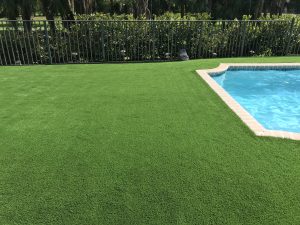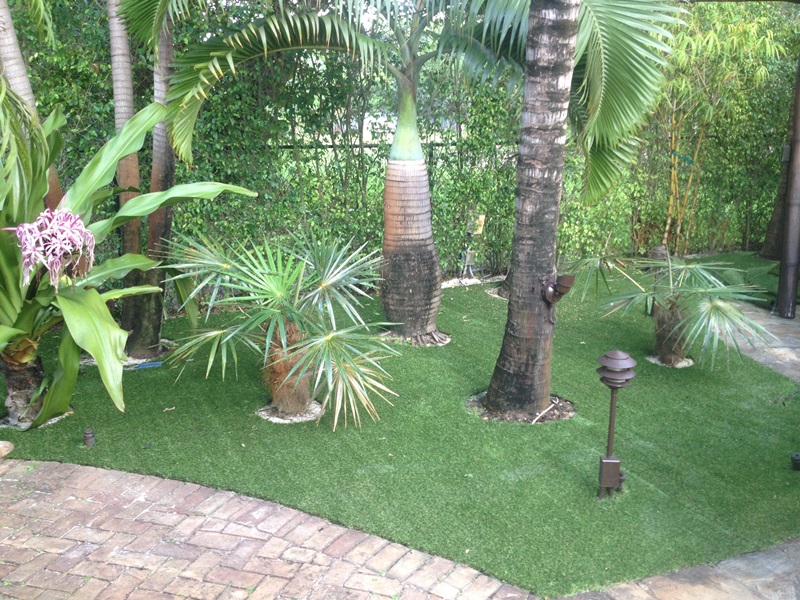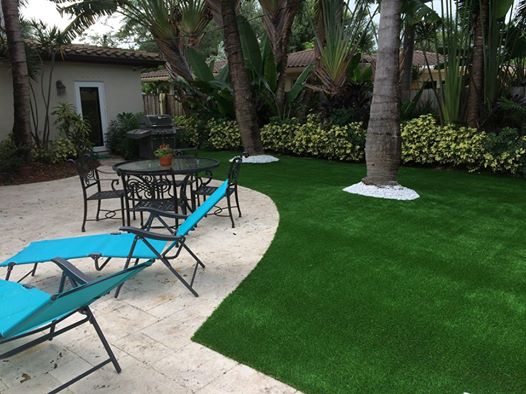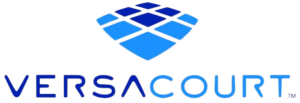What to Know BEFORE Buying Synthetic Turf- By Synthetic lawns of Florida, Boca Raton, Florida 1_2014.
Thinking of buying synthetic turf, also known as artificial grass, artificial turf, fake grass or by the commonly used brand name “Dura-Field™ “? Depending on the size of the area you are considering covering, synthetic turf can be a very large investment. The Synthetic turf Council at http://www.syntheticturfcouncil.org/?page=Research will provide you with in-depth Independent information you need to be an educated consumer and make your investment a wise one and not a costly mistake. As an educated consumer you can save yourself money and aggravation while making a purchase decision that you will be happy with for many years to come. If at any time in reading this guide you have questions or would like additional information, feel free to call us toll-Free at 866-577-8660 7 days a week.
In this Buying Guide you will:
1. Learn how synthetic turf is made so you can’t be ripped off
2. Know the 6 major types of synthetic turf to avoid costly buying mistakes
3. Learn the 5 different grades of turf and how to find out which one you are being sold
1. Learn how synthetic turf is made so you can’t be ripped off-Understanding the Different Components of Synthetic Turf aka Artificial Grass Once you understand what goes into making artificial grass, you can be better equipped to tell the difference between the products being sold to you. You will know what characteristics are associated with what components and how to choose the turf that will best meet your needs at the lowest costs.
Below is a brief explanation of each of these components:
Pile Height: this is the length of the longest blades. Average for landscape grass is 1.5″ to 2.0″ with 1.75″ being the most common. Average for athletic field turf is 2.0″ up to 3″ with 2.25-2.5″ being the most common. Putting green turfs have a wide range from 0.375″ to 1.25” depending on the type and planned use. For turf designed specifically for dog use,there are many choices, they will vary in pile height, but the shorter is the better choice on this one. Consumers should be aware that blade height and matting are only connected. Matting or the effect when the blades get pushed down is impacted by the density of the turf as well as the blade height.Face Weight: this is the weight of an area in ounces per square yard or Square Meter. The more dense it is – the more expensive it is, Well it is the same for synthetic turf. However, with artificial Lawns, the combination of face weight, pile height and yarn type all combine to determine the product’s density. The more dense the product, the softer it will feel under foot. Backing Type:There are two backings used on the production of the product. The Primary Backing is the layer(s) of material that the yarn is punched through in the process of making the artificial turf. Most common artificial grass uses two layers of primary backing, although some use a single layer instead of two layers and some turf will use a mesh or “stability layer” of material in between the layers of for added tuft bind or to help the blades stand up better. Easy rule: the more layers, the better.
The Secondary Backing is the coating on the back of the turf. This coating gives synthetic turf
its all-weather durability and most of its tuft bind. Without the secondary backing most synthetic turf would not last very long under normal usage, all would depend on the quality of the materials used. The exception is knitted turf which has no secondary backing but attains its longevity and durability by wrapping the blades of yarn around a single layer of mesh backing used in the knitting process, this process is very rare in the Industry. In the US most artificial turf is coated with polyurethane. The polyurethane coating is a little stronger and more durable. The latex coating is a little more environmentally friendly. The more ounces of secondary coating, the better. Range is 14-29 ounces per square yard, this will affect the tuft bind and durability, again all would depend on the quality of the polyurethane used and the process.
Backing Weight: this is simply the total weight of the layers of Primary backing and the ounces of Secondary coating used per square yard.
Total Weight: this is the total of the Face Weight and Backing Weight measurements. So it is always a good idea to ask a sales rep what the product’s face weight and total weight are to make sure you are comparing apples-to-apples.
Yarn Type: there are only three types of yarn used in artificial grass: Polyethylene, Polypropylene and Nylon. Each yarn has its own characteristics. Polyethylene has become the most commonly used for its greatest versatility and excellent balance between durability, aesthetics and softness.
Polypropylene yarn is typically used for sand-filled putting greens and as a thatch layer on landscape grasses. Nylon is also used as a thatch layer as well as nylon putting green turf. Some companies use nylon for their long blades of their landscape grasses. Nylon is the most porous of the three yarn types, so using it for dog applications may not be the best idea.Roll Width: synthetic turf is made in two common widths, 15 foot and 12.5 feet. Most US -made turf is 15 foot wide and most foreign-made turf is 12.5 foot wide. In some cases, a 15 foot wide good may make the installation easier or create less waste, in other cases the 12.5 foot wide good is the smarter choice based on the dimensions of the job and a desire to minimize waste. When considering which vendor to purchase your turf from, ask them to provide a cutting and seaming diagram based on your measurements and the diagram of your area to be covered with fake grass. A good synthetic turf vendor should be happy to provide this service and help you decide which width of synthetic turf would make the most sense for your specific job.
2. Know the 6 major types of synthetic turf to avoid costly buying mistakes What artificial grass product makes the most sense for your needs? There are six different types of synthetic turf made for different applications. Understanding which synthetic turf best suits your needs will help you to make a better purchase decision. Landscape Turf Landscape Turf is characterized by the thatch layer of yarn, also called the “root zone” or “micro fiber layer”. Regardless of what it is called, this curly lower layer of yarn is there to hold up the long blades that replicate the blades of grass and at the same time minimize, or in some cases totally eliminate, the need for infill to help keep the blades up. These artificial grasses are made to most look like real grass with some models even having a tan thatch to mimic the dead grass that you can see in a natural healthy lawn.
Landscape grasses typically have the highest amount of yarn per square yard and combined with the stitching of the thatch layer can make these the most expensive types of grasses to purchase. Pet Grass Artificial turf made specifically for use with dogs has a couple of unique characteristics. Most turf today will have antimicrobial agents built into the yarn as well as anti-mold to help minimize odors by killing the bacteria that cause the odors, generally odor will not be an issue due to Natural rainfall, but in dryer areas, a periodical watering will work as well. most turf is made specifically for excellent drainage, usually 30 Gallons of water per Square Meter. Look for products that have antimicrobial agents built into their yarn and unique backing styles designed to maximize drainage. Products designed for use with dogs are designed to be used without any infill. Some turf companies add a synthetic turf filled with rubber or sand or a combination of both, or ceramic “Durafill” or a “special odor control infill” can be used with dogs, this is generally not necessary unless you have a dog kennel. Feces is always recommended to be bagged as usual, then the area hosed down. Athletic Field Turf Artificial turf made for athletic fields is easy to identify. It will have no thatch layer and is typically 2 inches to 3 inches tall. The turf is designed to be in-filled with crumb rubber, silica sand, or most commonly a mixture of crumb rubber and silica sand. There are other alter native infills such as TPE (thermoplastic elastomer) and coconut-cork products, but these are much more expensive and/or unproven for long-term effectiveness as of 2010. Athletic field turf provides the safety for sports use, but can be problematic when used for general landscaping purposes. If no infill is used, the turf will lay on its side and not be attractive. When infill is used in a residential or commercial landscape application, the property owner must be aware that they may be experiencing these small rubber pellets all over their property and house. It is usually not a good idea to use athletic field turf for anything other than athletic use. A competent sales rep should explain which type of turf is best for your specific needs and if you as the consumer are feeling that the sales rep is just trying to sell you the turf that they have in stock, then you are likely not getting the turf that best meets your specific needs. Claims that “we have hundreds of residential and commercial properties that use our athletic field turf for their landscaping” should not be accepted as evidence that this type of system is best for landscape applications. It is more likely the fact that athletic field turf has been used for many more years than the newer landscape turf and that’s why many property owners ended up with this type of turf for their landscape applications. Putting Green Turf There are two types of synthetic turf used for putting greens. Nylon putting green turf is the kind that you will see inside a sports store, at a miniature golf facility, or most any indoor applications. It can also be used outdoors. This turf is characterized by the curly nylon yarn that is typically about 1/4 inch to 1/2 inch high. It is often called “non-infill” turf because it does not require any sand infill. The advantage of nylon putting green turf is that it will roll at approximately a 10 stimpmeter rating right from the day it is installed. The yarns are unidirectional meeting that it will roll true from both directions the day it is installed. For the do it yourself customer a nylon putting green turf is a little easier to install. The disadvantages include shorter expected life span versus polypropylene putting greens, no ability to adjust the speed, and a ball roll that is not as smooth as a properly installed polypropylene turf. The second type of putting green turf is called polypropylene or “sand filled” turf. As the name would imply, this turf is filled with silica sand to approximately 1/8 to 1/4 inch below the top of the blades. The blades are then bent down with a water-filled roller so that the completed putting green mimics a bent grass green. The advantages of a polypropylene putting green include a longer expected life span, the ability to adjust the speed, and the ability to accept a shot from a distance as the sand will dissipate the energy of the ball and allow the polypropylene putting green to act more like a natural green than the non-infilled nylon green. A polypropylene putting green does have some disadvantages as well. There is more work involved in installing one giving that it must be filled with silica sand and rolled repeatedly until the tips of the blades stay down. This “break-in process” can take days or weeks depending on the amount of sun the putting green gets, the temperature and the amount it is rolled. Once the sand-filled putting green is broken in, it will typically have the better ball roll as compared to nylon.
Synthetic turf for playgrounds is actually a very dense landscape turf laid over some type of padding. Common padding includes rubber or foam padding that is made specifically to be used outdoors. Depending on the thickness of the padding and the density of the artificial grass, these systems can provide fall height protection of up to 10 feet without using rubber infill in the turf. An alternative would be to use athletic field turf filled with rubber, however since most playgrounds are adjacent to schools or daycare centers, the use of rubber infill can be very messy as the children play and the rubber gets on their clothes and shoes and is brought into the facility. This is why the modern padded systems are becoming popular over the traditional rubber infill systems. The modern padded systems are typically less expensive than poured in place rubber or rubber tiles and provide a natural look and often a longer lifespan than these two common playground surface options. Specialty Turf Any artificial turf that does not fit in one of the categories above can be considered Specialty Turf. For example, Perfect Turf’s Multiuse Turf would fit in this category. Turf that is designed for indoor use, balconies, or other special applications would be in this category. Often times, special applications such as turf used for road medians are a combination of landscape turf and specially designed base construction and turf attachment methods that make up the overall turf system. Turf for Bocce Ball courts, tennis courts, and running tracks would all fit in this category.
3. Learn the 5 different grades of turf and how to find out which one you are being sold Understanding First Quality vs Overruns, Closeouts, Factory Seconds and what to know about Used Turf If you spend a good deal of time researching artificial grass on the Internet, you will find enough conflicting information about synthetic turf to make your head spin. In this section we will try to make sense of the different types of fake grass sold on the Internet and provide you with some questions to help you determine what any particular company is trying to sell you. First-Quality Turf: As the name would imply, first-quality turf would be the top quality produced by the manufacturer. Most first-quality turf will come with an eight-year warranty against fading and fiber degradation. Watch out for companies that provide a warranty longer than eight years. Ask to see a printed warranty. The actual manufacturer is probably providing an eight-year warranty and it is the reseller who is adding length to that warranty, possibly with the intention of not ever paying out on
it. You should expect a turf that is free of defects and performs to the specifications as outlined in the product information sheet. If the reseller cannot provide one, you are likely not getting first-quality turf. When purchasing first quality turf, an educated consumer should expect the final product to closely match the sample that the manufacturer/reseller should provide to you prior to purchase. Color variations can be explained by dye lot differences, but the turf should be very similar to the sample in face weight/density, blade height and backing thickness. A key question to identify whether you are being sold first-quality turf is to ask for the printed warranty that will come with the product. Overruns, Closeouts and Factory Seconds: One of the common complaints of the artificial grass industry is that consumers are often sold factory seconds without their knowledge. When a reseller uses the words “overruns”, “closeouts”, “discontinued lines”, “remnants” or “excess inventory” these are often used to mask the fact that the reseller is selling factory seconds. Overruns do exist, but they are not common. Factory seconds can be a good purchase for specific applications where a defect may not make a difference. An example could be the side of a house where no one is really going to be looking at the turf, but it is needed to keep the area green and clean versus a muddy mess. Most factory seconds will have lines in the turf caused by a spool of yarn having a different dye lot or running out during production and not being caught by the machine operator. Some resellers will call these “lawnmower marks” but they are really defects in production. A wise consumer can tell if they are being sold factory seconds by first, asking directly and second asking for a copy of the warranty. These products can be sold for up to 50% less than first quality goods, which can be another clue. If the reseller insists that their inexpensive products are simply first-quality overruns, ask for a copy of the printed warranty and a written agreement that the product will be received with no defects or the reseller will replace the entire roll at their expense including shipping.
2571 W Hillsboro Blvd, Deerfield Beach, Florida 33442
Ofc (561) 372-4655. Toll Free (954) 366-5244. Cell (561) 870-5130
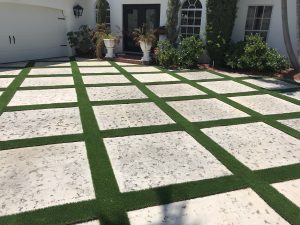 Summer has arrived and for a lot of people that means it’s time to garden and get their yard looking beautiful. If you’re like most homeowners, then you know just how much money it costs to maintain natural grass. It does cost a lot of green to keep it looking green. The good news is that you can have synthetic grass professionally installed and save yourself a lot of money. What you do with that money is up to you. Read on to find why so many homeowners are making the switch to artificial grass yard and lawns. You’ll be glad that you did when you see how much money you can save.
Summer has arrived and for a lot of people that means it’s time to garden and get their yard looking beautiful. If you’re like most homeowners, then you know just how much money it costs to maintain natural grass. It does cost a lot of green to keep it looking green. The good news is that you can have synthetic grass professionally installed and save yourself a lot of money. What you do with that money is up to you. Read on to find why so many homeowners are making the switch to artificial grass yard and lawns. You’ll be glad that you did when you see how much money you can save.

